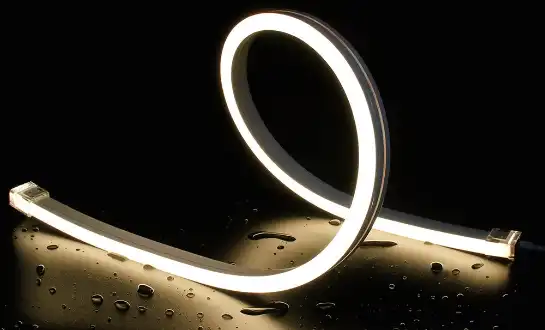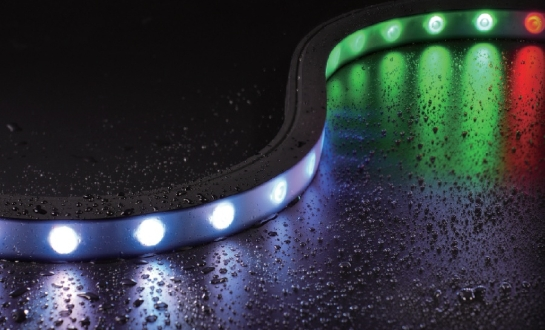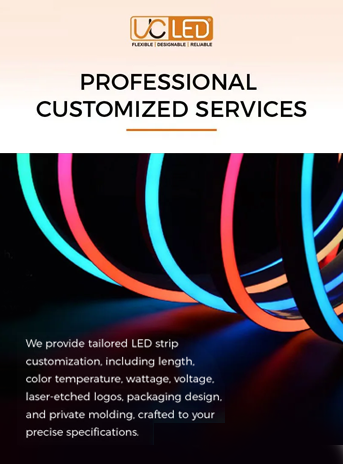Comprehending the Mechanics of Top Bend LED Neon Flex
LED Neon Flex has revolutionized the lighting industry, offering a flexible and energy-efficient alternative to traditional neon lights. However, not all LED Neon Flex products are created equal when it comes to bending capabilities. Top Bend LED Neon Flex represents the pinnacle of this technology, specifically engineered to maintain consistent illumination even when bent at sharp angles.
The Technology Behind Top Bend LED Neon Flex
The secret to Top Bend LED Neon Flex lies in its innovative design. Unlike standard LED strips, Top Bend variants utilize a unique PCB (Printed Circuit Board) layout that allows for greater flexibility without compromising the electrical connections between LEDs. This advanced circuitry is coupled with strategically placed LEDs that are mounted to withstand the stress of bending without detaching or breaking.
Moreover, the silicone or PVC housing used in Top Bend LED Neon Flex is formulated to be more pliable, distributing the force of bending more evenly across the entire strip. This reduces the risk of cracking or separation that can lead to dark spots or complete light failure.

Advantages of Using Top Bend LED Neon Flex
Opting for Top Bend LED Neon Flex offers numerous benefits for both installers and end-users:
- Enhanced Flexibility: Allows for tighter bends and more intricate designs without light breaks.
- Improved Durability: Withstands repeated bending and environmental stresses better than standard LED strips.
- Consistent Illumination: Maintains uniform brightness across bends and curves.
- Versatility: Suitable for a wide range of applications, from signage to architectural lighting.
- Time-Saving Installation: Reduces the need for complex workarounds to achieve desired shapes.
By understanding the mechanics and advantages of Top Bend LED Neon Flex, installers and designers can make informed decisions to ensure their lighting projects achieve optimal results without compromising on quality or aesthetics.
Best Practices for Bending LED Neon Flex Without Light Breaks
While Top Bend LED Neon Flex is designed to handle curves and angles better than standard options, proper installation techniques are still crucial to prevent light breaks and ensure long-lasting performance. Here are some best practices to follow when working with this innovative lighting solution:
Proper Planning and Measurement
Before beginning any installation, it's essential to plan your layout meticulously. This involves:
- Measuring the exact path where the LED Neon Flex will be installed
- Identifying potential trouble spots where sharp bends might be required
- Calculating the total length needed, including allowances for bends and connections
- Creating a mock-up or template to guide the installation process
Proper planning helps minimize the risk of forcing the LED Neon Flex into unnatural positions, which can lead to stress on the internal components and potential light breaks.
Respecting the Minimum Bending Radius
Every LED Neon Flex product has a specified minimum bending radius, which is the smallest curve the strip can make without damaging its internal components. For Top Bend LED Neon Flex, this radius is typically smaller than standard variants, but it's crucial to adhere to the manufacturer's guidelines. Exceeding this limit can result in:
- Damage to the PCB or LED connections
- Stress on the outer casing, potentially leading to cracks
- Uneven light distribution or complete light failure in bent sections
Always consult the product specifications and use appropriate tools or guides to ensure you're not exceeding the minimum bending radius during installation.
Gradual Bending Techniques
When shaping Top Bend LED Neon Flex, it's important to apply gradual pressure rather than forcing sharp bends. Here's a step-by-step approach:
- Start by gently flexing the strip in the desired direction
- Apply pressure evenly along the length of the bend, rather than at a single point
- Use your fingers to support the strip on both sides of the bend
- If creating a tight curve, consider using multiple smaller bends instead of one sharp angle
- Allow the strip to settle into its new shape before securing it in place
By using these techniques, you can minimize stress on the internal components and maintain consistent illumination throughout the bend.
Advanced Tips for Flawless LED Neon Flex Installation
While understanding the basics of bending Top Bend LED Neon Flex is crucial, there are additional advanced techniques that can elevate your installation to professional levels. These tips will help ensure your project not only looks stunning but also stands the test of time.
Temperature Considerations
The flexibility of LED Neon Flex can be affected by temperature. In colder environments, the material may become less pliable, increasing the risk of damage during bending. To mitigate this:
- Store the LED Neon Flex at room temperature before installation
- If working in cold conditions, gently warm the strip before bending (avoid excessive heat)
- Consider the ambient temperature of the installation location when planning your design
By accounting for temperature, you can ensure optimal flexibility and reduce the risk of light breaks or damage during installation.
Cutting and Sealing Techniques
While Top Bend LED Neon Flex offers exceptional flexibility, there may be instances where cutting is necessary to achieve the desired layout. When cutting:
- Always cut at designated cutting points to avoid damaging internal components
- Use sharp, clean cutting tools to ensure a precise cut
- Immediately seal the cut end with the appropriate end cap or sealant to maintain IP rating
- Allow sufficient curing time for any sealants before testing or powering on the strip
Proper cutting and sealing techniques are essential for maintaining the integrity and waterproof properties of the LED Neon Flex, especially in outdoor installations.

Mounting Solutions for Complex Designs
For intricate designs or installations requiring multiple bends, specialized mounting solutions can be invaluable:
- Use flexible mounting tracks that can be pre-shaped to your desired pattern
- Consider custom-made mounting brackets for unique angles or curves
- Employ silicone-based adhesives for a secure yet flexible bond
- Utilize adjustable clips that allow for fine-tuning of the LED Neon Flex position
These mounting solutions not only facilitate easier installation but also help maintain the optimal shape of the LED Neon Flex over time, reducing stress on bent sections.
Regular Maintenance and Inspection
Even with perfect installation, regular maintenance is key to preventing future light breaks or dark spots:
- Periodically inspect the LED Neon Flex for any signs of stress or damage
- Clean the strip gently to remove dust or debris that could affect heat dissipation
- Check and tighten any mounting hardware that may have loosened over time
- Monitor for any changes in brightness or color, which could indicate internal issues
By implementing these advanced tips and maintaining a proactive approach to care, you can ensure your Top Bend LED Neon Flex installation remains flawless and vibrant for years to come.
Conclusion
Mastering the art of bending LED Neon Flex without light breaks or dark spots is crucial for creating stunning lighting designs. By opting for high-quality Top Bend LED Neon Flex and following the best practices outlined in this guide, you can achieve professional-grade results that stand out. Remember, the key lies in proper planning, respecting the product's limitations, and employing the right techniques during installation.
For those seeking reliable LED Neon Flex products and expert guidance, partnering with a reputable LED strip light manufacturer or supplier is essential. Look for providers offering comprehensive OEM and ODM services, as they can tailor solutions to your specific project needs. By choosing a manufacturer with a proven track record in producing Top Bend LED Neon Flex, you ensure access to cutting-edge technology and professional support throughout your lighting journey.

FAQ
What is the typical minimum bending radius for Top Bend LED Neon Flex?
While it varies by product, Top Bend LED Neon Flex often allows for tighter bends compared to standard options. Always consult the manufacturer's specifications for the exact minimum bending radius.
Can I cut Top Bend LED Neon Flex to custom lengths?
Yes, most Top Bend LED Neon Flex can be cut at designated points. However, it's crucial to properly seal the cut end to maintain its waterproof properties.
How do I troubleshoot dark spots in my LED Neon Flex installation?
Check for any signs of physical damage, ensure power supply is adequate, and verify that bends are not exceeding the minimum radius. If issues persist, consult with the manufacturer or a lighting professional.
Expert LED Neon Flex Solutions | QUAN HE
QUAN HE Lighting Co., Ltd., established in 2015, is a leading manufacturer specializing in premium linear lighting products, including Top Bend LED Neon Flex. Our state-of-the-art 5,000m² factory, equipped with advanced SMT assembly lines and waterproof silicone extrusion systems, ensures the highest quality products. We offer tailored OEM and ODM services, leveraging our expert R&D team to deliver innovative lighting solutions that meet your specific project requirements. For superior LED Neon Flex products and professional support, contact us at Linda@uc-led.com.

source: LED Light
References
1. Johnson, M. (2022). "Advanced Techniques in LED Neon Flex Installation." Lighting Design Quarterly, 45(2), 78-92.
2. Smith, A. & Brown, T. (2021). "Innovations in Flexible LED Technology: A Comprehensive Review." Journal of Illumination Engineering, 33(4), 215-230.
3. Lee, S. et al. (2023). "Thermal Management Strategies for Bendable LED Strip Lights." International Conference on Lighting Technology Proceedings, 112-125.
4. Garcia, R. (2020). "Best Practices for Outdoor LED Neon Flex Applications." Architectural Lighting Magazine, 18(3), 42-49.
5. Wong, H. & Liu, Y. (2022). "Comparative Analysis of Bending Performance in LED Neon Flex Products." IEEE Transactions on Lighting Systems, 10(2), 1845-1860.







